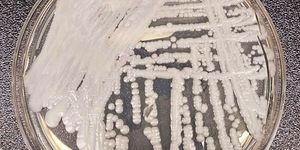Insight Into a DNA Damage Sensor That Orchestrates Repair
Simple cell functions like division or metabolism can lead to DNA damage, which can also occur because of normal exposure to the sun or noxious agents in the environment. So our DNA is constantly suffering damage, which can lead to diseases like cancer if our cells don't correct the errors that arise. Researchers have now learned more about how cells repair DNA damage. The findings, reported in Nature Structural and Molecular Biology, have revealed the role of a protein called UV-DDB (ultraviolet-damaged DNA-binding), which is known to protect cells from the sun. This work has found that UV-DDB searchers for general DNA damage and orchestrates the actions of the repair crew.
UV-DDB (red) detects damage, and (green) repair molecule OGG1 meets it (yellow) where the DNA strand needs repair. After the job's complete, OGG1 detaches. (Video slowed to 1/18 speed)
"If you're going to fix a pothole, you have to find it first. That's what UV-DDB does. It identifies DNA damage so that another crew can come in and patch and seal it," explained study senior author Bennett Van Houten, Ph.D., professor of pharmacology and chemical biology at the Pitt School of Medicine and UPMC Hillman Cancer Center.
Every one of our cells contains a copy of the genome, which has to be carefully packaged so it will fit in the nucleus. Assessing the tightly-wound genetic material is difficult; not all of it can be accessed easily. The UV-DDB molecule is able to use a dual approach. It can search for those so-called potholes by walking the genetic 'road' or by surveying it from above.
"UV-DDB is like a helicopter that can land and then roll for a couple blocks," Van Houten explained. "It also has the ability to find damage buried in chromosomes and help DNA repair molecules go places they otherwise couldn't, the way a helicopter can navigate really hilly areas."
Once the damage is located, UV-DDB conducts the response, getting the repair crew where it needs to be, and finishing the job quickly. Led by Van Houten, the team observed the process at the molecular level, on a strand of DNA suspended between silica beads.
Two molecules work together to repair damaged DNA that's stretched between two silica beads.
"The amazing thing is finding those single molecules in 3D space," said study co-author Simon Watkins, Ph.D., director of Pitt's Center for Biological Imaging. "[Van Houten]'s team has developed an assay that allows them to track the repair enzymes in 3D on the DNA ropes as they repair damage."
The researchers confirmed their findings in cells that suffered damage to their telomeres - the protective caps on chromosome ends. Once again, UV-DDB came on the scene.
This work also provides insight into a rare disorder called xeroderma pigmentosum (described in the video below). Patients are very sensitive to the sun, and typically get skin cancer. Their UV-DDB is not active - and can't initiate DNA repair effectively. When cancer patients carry high levels of UV-DDB, however, they have a better response to treatment.
"It's clear this protein is involved in a very fundamental problem," Van Houten said. "We could not have evolved out of the slime if we didn't have good DNA repair."
Sources: AAAS/Eurekalert! Via University of Pittsburgh, Nature Structural & Molecular Biology









